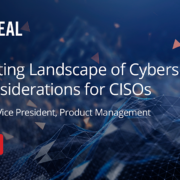The Shifting Landscape of Cybersecurity: Top Considerations for CISOs
1. AI Is Changing the Game
The increasing use of generative AI tools such as ChatGPT comes with both defensive and offensive impacts. On the defensive side, companies can leverage these solutions to analyze security data in real time and provide recommendations for incident response and security vendors developers can write code faster. As for the offensive impact, attackers may be able to optimize malware coding using these same AI tools or leverage code released unknowingly by a security vendor’s developer. If malicious actors can hide compromising code in plain sight, AI solutions may not recognize the potential risk. And if hackers ask generative AI to circumvent network defenses leveraging code released unknowingly, the impact could be significant.
As a result, according to The Wall Street Journal & Forbes, JPMorgan Chase, Amazon, Bank of America, Citigroup, Deutsche Bank, Goldman Sachs and Wells Fargo are limiting employees’ ChatGPT use and we expect to see other companies follow.
2. Market Forces Are Shaping Security and Resilience
The looming economic recession is shaping corporate practices around security and resilience. While many IT teams will see their budgets unchanged or even increased in 2023 compared to 2022, security professionals should also expect greater oversight from C-suite executives, including chief information officers (CIOs), chief information security officers (CISOs), and chief financial officers (CFOs).
Both CIOs and CISOs will expect teams to justify their spending rather than simply giving them a blank slate for purchasing, even if the budget is approved. CFOs, meanwhile, want to ensure that every dollar is accounted for and that security solutions are helping drive business return on investment.
Consider network and cloud mapping solutions that help companies understand what’s on their network, where, and how it’s all connected. From an information security perspective, these tools have value because they limit the frequency and severity of IT incidents. But from a CFO perspective, the value of these tools ties to their ability to save money by avoiding the costs that come with detection, remediation, and the potential reputation fallout that occurs if customer data is compromised and acts as a force multiplier across multiple teams.
3. Multiple Vendor Architecture Is Everywhere
Firewall options from cloud vendors do not meet the enterprise’s security requirement. Enterprises are deploying traditional firewalls (ex. Palo Alto Network, Cisco or Fortinet) in their clouds. They are using cloud workload protection tools from vendors such as Crowdstrike or SentinelOne.
On-premises or cloud deployments cannot be treated in a silo. An adversary could get in from anywhere and go anywhere. The infrastructure has to be treated as one with proper segmentation. Pure-play cloud companies are also switching to on-premises collocated data centers to save on their rising cloud costs.
4. Public Oversight Impacts Private Operations
The recently announced National Cybersecurity Strategy takes aim at current responsibilities and long-term investments. According to the Strategy, there must be a rebalancing of responsibilities to defend cyberspace that shifts away from individuals and small businesses and “onto the organizations that are the most capable and best-positioned to reduce risks for all of us.” The strategy also recommends that businesses balance short- and long-term security investments to provide sustained defense over time.
To help companies achieve these goals, the Cybersecurity and Infrastructure Security Agency (CISA) recently released version 1.0.1 of its cross-sector cybersecurity performance goals (CPGs). Many of these goals fall under the broader concept of “security hygiene,” basic tasks that all companies should complete regularly but that often slip through the cracks.
For example, CPG 2.F recommends that companies use network segmentation to limit the impact of Indicator of Compromise (IOC) events. CPG 1.A, meanwhile, suggests that companies inventory all IT and OT assets in use, tag them with unique identifiers, and update this list monthly.
While no formal announcements have been made, it’s possible that under the new strategy, CISA will shift from providing guidance to enforcing regulatory expectations. For example, FDA may mandate pharmaceutical companies to submit their compliance to CISA CPGs.
5. IT and OT Meet in the Middle
RSA 2023 also touched on the continued merger of IT and OT environments. For many companies, this is a challenging shift. While IT solutions have been navigating the public/private divide for years, many OT frameworks are still not designed to handle this level of connectivity.
The result? A rapidly increasing attack surface that offers new pathways of compromise. Consider an industrial control system (ICS) or supervisory control and data acquisition (SCADA) system that was historically air-gapped but now connects to internal IT tools, which in turn connect to public cloud frameworks. If attackers are able to compromise the perimeter and move laterally across IT environments into OT networks, they will be able to encrypt or exfiltrate customers’ personal and financial data. Given the use of trusted credentials to access these systems, it could be weeks or months before companies notice the issue.
To mitigate the risks, businesses are looking for ways to segment IT and OT plus continuously validate segmentation policies are met. This starts with the discovery and classification of OT devices along with the development of standards-based security policies for both IT and OT functions. These two networks serve different aims and need to avoid the risk of any lateral movement between the networks.
Old, New, and Everything in Between
OT threats are on the horizon, companies need to prioritize basic security hygiene, and economic downturns are impacting IT budgets. These familiar frustrations, however, are met by the evolution of AI tools and the development of new national strategies to combat emerging cyber threats. As we look towards the second half of the year, the lessons learned can help companies better protect what they have and prepare for the next generation of cybersecurity threats. Take on the new cybersecurity landscape with RedSeal. Reach out to see how we can help you.
[/av_textblock]


